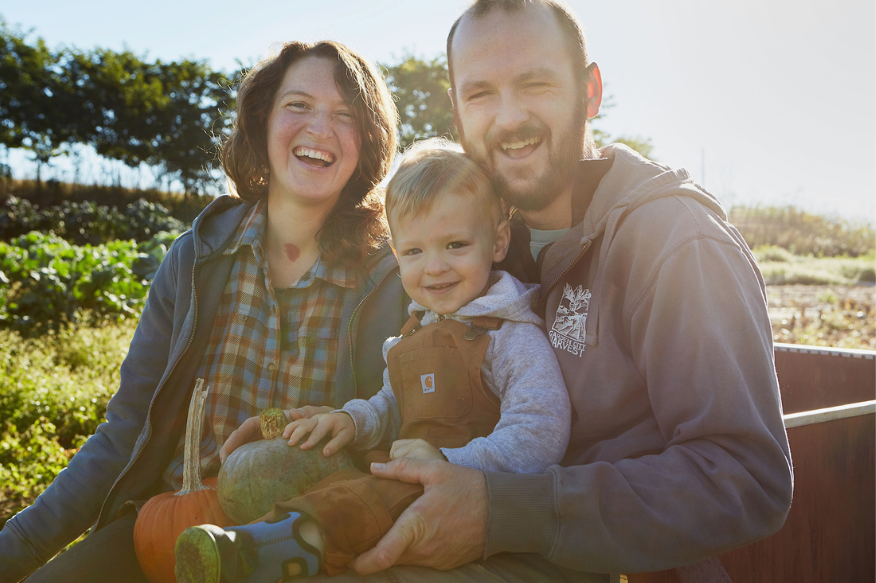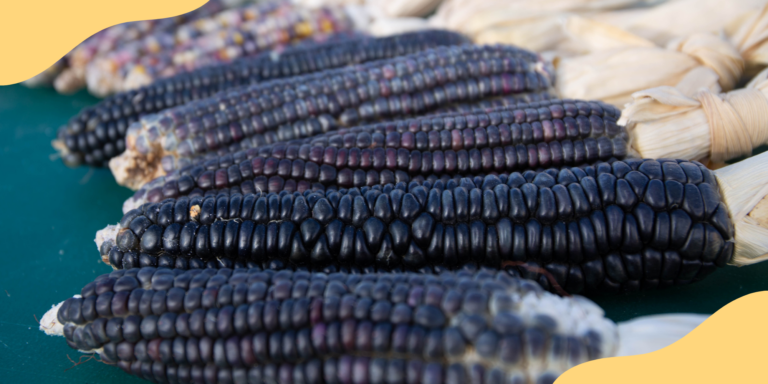Alumni Farmer Spotlight: Pete Kerns and Natasha Hegmann’s Shared Stewardship
Pete Kerns and Natasha Hegmann are realizing their childhood dreams of farming.
Pete Kerns and Natasha Hegmann are realizing their childhood dreams of farming.

This month, we’re featuring a few FoodCorps alumni farmers who are nourishing their communities. From small-scale farms to larger productions, these farmers’ stories highlight the profound impact of local food on schools and communities. We hope their stories will shed light on the importance of the farm to school and local food movements.
Make sure to read our other stories about farmers who served with FoodCorps, including Molly Schintler, Christopher Horne, and LaBria Lane.
On a 280-acre conservation nonprofit near Elkport, Iowa, farmers Pete Kerns and Natasha Hegmann operate Turkey River Farm and Greenhouse. The couple started the farm in 2016, renting the land from the Communia Corporation organization. Together, they’re live-in caretakers of the land and grow a variety of vegetables, culinary mushrooms, and pasture-raised pigs on five acres.
The farm realizes childhood dreams for both the farmers: Pete started baking with his grandmother as a child, then started his own catering company in high school. And growing up in this rural Iowa region, Natasha always aspired to farm vegetables.
Pete and Natasha both knew that they wanted to explore the connections among cooking, agriculture, and sustainability, so they each applied to become a FoodCorps service member in partnership with AmeriCorps.
After meeting at their FoodCorps orientation in California, Pete and Natasha became a couple and served together for two years in Montana. After they completed their service, Natasha worked as the dining services garden manager at the University of Montana, then they began stewarding the land where they created their farm.
Today, Pete and Natasha provide vegetables to about 75 Community Supported Agriculture (CSA) members. Located in a low-income rural county and region, they also donate to local food banks directly and through customer-funded CSA shares.
Both farmers emphasize the importance of responsible land stewardship. The farm uses practices that build topsoil, protect waterways, minimize fossil fuel inputs, and support biodiversity.
Natasha especially appreciates supporting education, conservation and healthy families in her hometown through the farm business. She and Pete also volunteer with the school cooking and gardening clubs, extension, and conservation organizations.
Turkey River Farm and Greenhouse also offers a program that exchanges a CSA share for four hours per week of volunteering. And through its participation in Worldwide Opportunities on Organic Farms (WWOOF), the farm welcomes volunteers from around the world to work alongside Pete, Natasha, and local community volunteers.
“Those interactions have been some of the most meaningful I’ve experienced,” said Pete, who with Natasha has made these opportunities explicitly inclusive, queer-friendly, and antiracist.
Pete and Natasha acknowledge that as young farmers who did not come from a farming family, race and educational privilege helped them attain access to land and funding through a Farm Service Agency (FSA) loan.
“You’re either born into it or have the privilege of being able to get into it,” said Pete.
Pointing out the racial inequities that have excluded farmers of color from decades of economic opportunities, Pete said, “Loan forgiveness for Black farmers has been caught in the courts because of privileged farmers who have never experienced the kind of discrimination that Black farmers face.”
Pete and Natasha, like other small farmers, feel the need for agricultural reform—from the debilitating lack of rural access to health care and mental health services to federal crop insurance that allows farmers to plant crops in floodplains.
Pete underscored the importance of grants and procurement changes that would make it easier for schools to source foods such as fresh fruit and vegetables from local producers. For example, the U.S. Commodity Foods program can undercut local producers by offering surplus, conventionally produced food products to schools for free. Local food producers usually do not have the scale that can serve an institutional market. And competitive food purchasing bidding processes often exclude local producers. Together, these can be enormous barriers for supplying school food programs—especially when schools and districts struggle to make ends meet.
“Funding for school meal programs isn’t enough to feed children a nutritious, scratch-made and even partially local meal,” said Pete. “It certainly isn’t enough for public school food services to hire enough help to cook foods from scratch.”
In 2020 Pete and Natasha purchased a retail greenhouse that sells flowers, supplies, and vegetable transplants to help community members get started with gardening and growing their own food.
“We wouldn’t be able to do this without the community,” said Pete. Their greenhouse has been instrumental in growing their business beyond CSA shares by allowing them to interact directly with community members.
These exchanges highlight the benefits that customers experience: more energy, nutritious eating, and their joy in preparing produce.
“We see improvements in individual people’s health,” said Pete. “By volunteering with, growing food for, and sharing recipes with our community, we can share knowledge and encourage community members to eat more vegetables.”

9 Thoughtful Holiday Gifts Made by FoodCorps Alumni

The Policy Brief, Fall 2024: After the Election

Food as Medicine: Teaching Indigenous Foodways